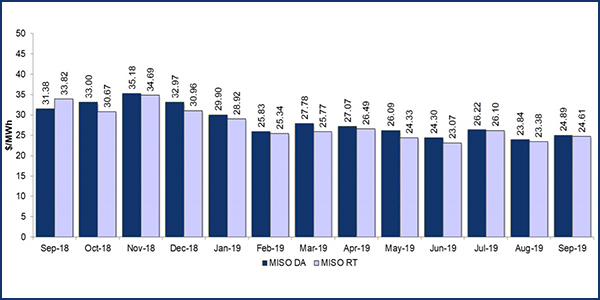CARMEL, Ind. — MISO is rearranging its Integrated Roadmap schedule to update the list of market improvements annually instead of the existing nearly two-year timeline.
The RTO said it will cut the Integrated Roadmap from 20 months to 13 months to put it in sync with the MISO’s annual budget process and the Independent Market Monitor’s yearly State of the Market Report. The Monitor’s recommendations are regularly folded into the ongoing list of market improvements.
MISO is suggesting a one-time shift of the Integrated Roadmap to cut seven months out of the process from recommendation to numbered roadmap item. After the change, stakeholder prioritization of recommendations will take place in March instead of July.
At an Informational Forum on Tuesday, market strategy team member Christov Churchward said the move to the new timeline will be implemented by the end of the year, nudging the new issue submission for the 2020 roadmap to Dec. 23 instead of the usual cutoff in the beginning of May. MISO and stakeholders’ issue prioritization is slated to begin Jan. 22 and wrap in the first half of April.
“This will continue to make the Integrated Roadmap even more integrated,” Churchward said.
MISO plans to hold a workshop Nov. 7 to discuss which improvements it will undertake with stakeholders from 2020 through 2025. (See Stakeholders Confused over MISO Roadmap.)
Prices, Peak Stay Low in Hot September
MISO’s average load in September nearly matched load at the same time last year, though peak loads stayed significantly below September 2018.
The RTO reported a 79.5-GW average load throughout the month, in line with the 79.4-GW average load in 2018. It hit an almost 107-GW peak on Sept. 11, well below the 115-GW peak on Sept. 4, 2018.
MISO said parts of its South and Central regions were 6 to 7 degrees Fahrenheit above the National Oceanic and Atmospheric Administration’s 30-year September historical average.
“We had a warm enough September this year — even warmer than last year,” Executive Director of Market Operations Shawn McFarlane said.
The RTO called a hot weather alert in MISO South for Sept. 5-9, when average high temperatures stayed above 95 degrees. Despite this, MISO was able to keep “good supply availability,” McFarlane said.
In mid-September, RTO executives predicted MISO’s forecasted 112-GW fall peak wouldn’t come to pass with the worst of September heat behind the footprint. (See MISO Unruffled by Fall Supply-demand Outlook.)
Despite warm weather loads, prices stayed low, with MISO averaging a $24.61/MWh real-time LMP — a 27% decrease compared to September 2018 when real-time prices averaged $33.82/MWh. McFarlane said the low prices were a product of strong natural gas supply and low fuel prices.
— Amanda Durish Cook





